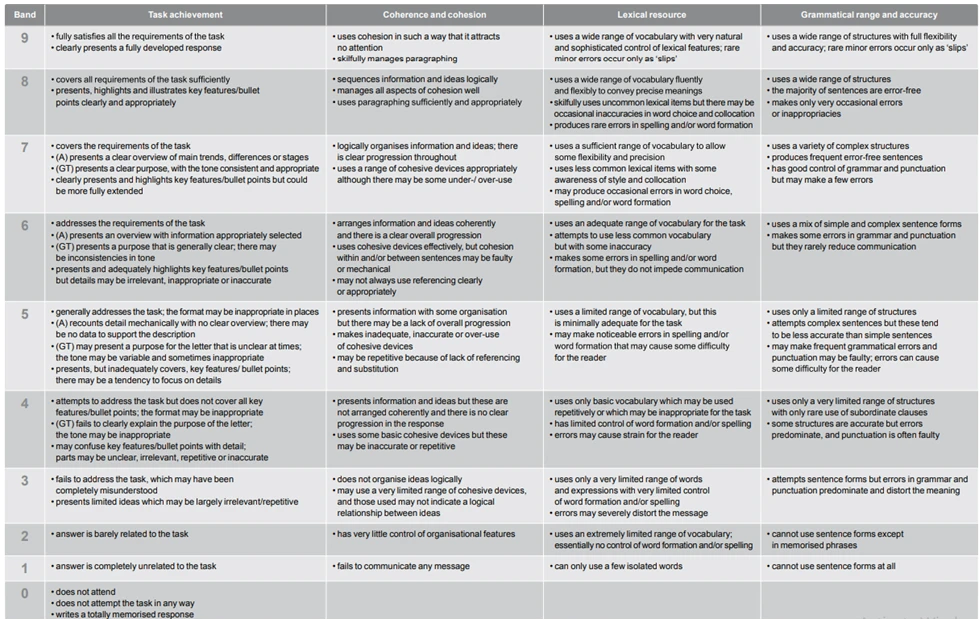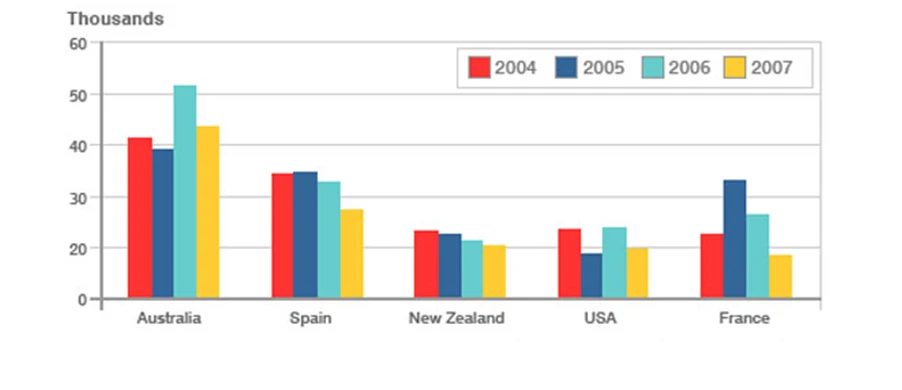Your cart is currently empty!
Category: Writing Module
-
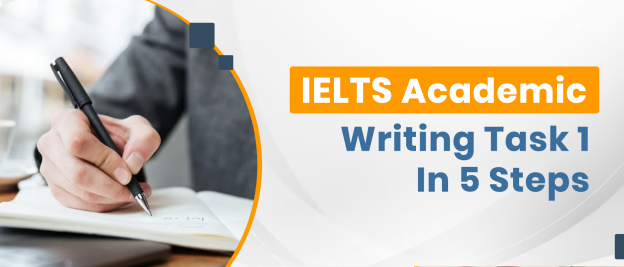
IELTS Academic Writing Task 1 In 5 Steps
Writing Task 1
You must write 150 words for Academic Writing Task 1 of the IELTS about a process, a map, or data presented in the form of a bar chart, line graph, pie chart, or table. Many students struggle with this skill because they haven’t practised it before. Understanding how your essay will be graded and using that knowledge to write an essay that gives the examiner exactly what they want will help you perform well on IELTS Writing Task 1.
Follow these five simple steps, and you’ll be on your way to success!
- Understand the marking criteria
- Paraphrase the question
- Write an overview
- Support overview with detail
- Check your work
The task is made significantly simpler by breaking it up into smaller components. I’ll go over each of the five steps in greater detail below, followed by some sample responses so you can see how it actually works in the real world.
Please keep in mind that I will provide you with the opportunity to edit my work at the conclusion, so please do not be overly critical in the comments section if you find any errors. Intentional errors are made to highlight the importance of double-checking your work and giving people time to consider the solution.
The following Task 1 Question will be used to guide us:
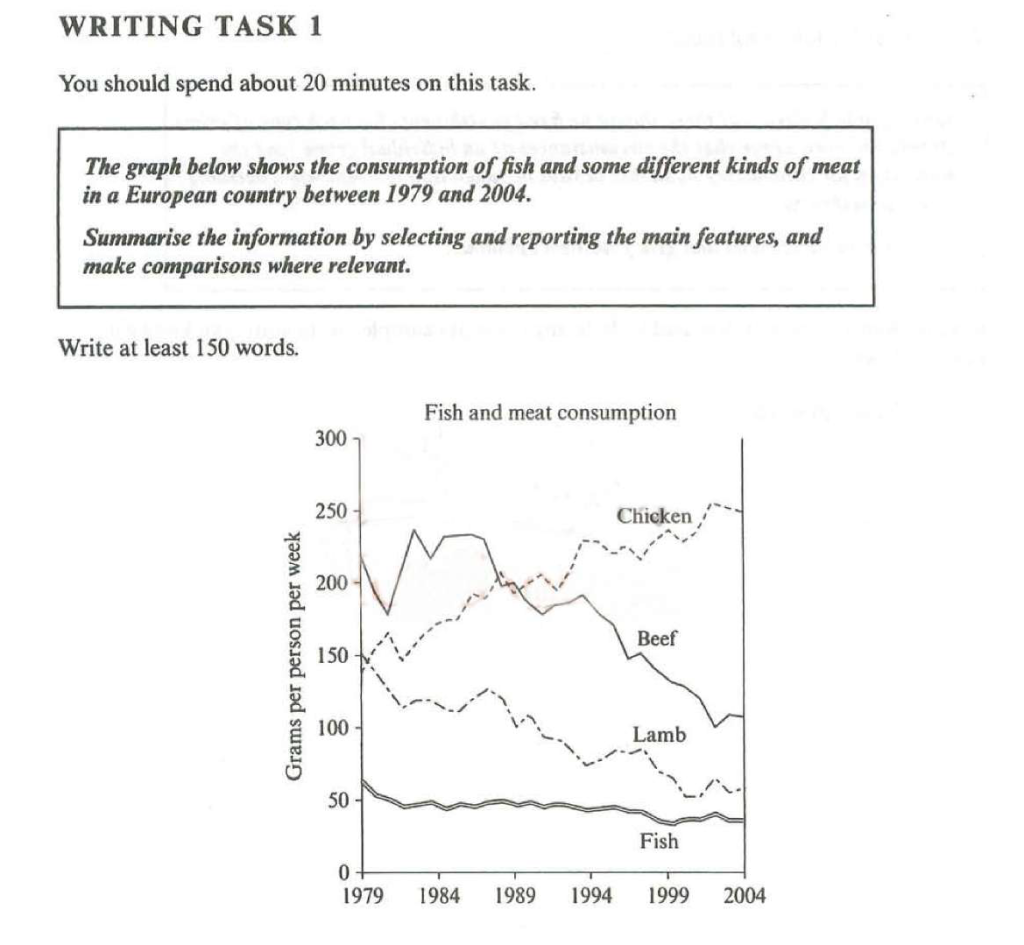
Marking Criterion
Task Achievement 25% Coherence and Cohesion 25% Lexical Resource 25% Grammatical Range and accuracy 25% If you’re confused by any of these expressions, don’t worry; I’ll go over each one in more detail below and provide a clearer explanation of what it means. The official marking guidelines are available.
Task Achievement
Your capacity to respond to the question accurately is referred to as task achievement. To accomplish this, you must complete all of the tasks outlined in the question and then write an answer that is both concise and comprehensive.
You’ll achieve a higher grade if you:
- Select the main/key features of the graph, chart, map or process.
- Write a clear overview that includes the main/key features (main trends, differences, stages etc.) of the graph, chart, map or process.
- Support them with accurate detail.
- Write at least 150 words.
Coherence and Cohesion
The ability to connect your ideas in a logical and understandable manner is referred to as coherence. Most of this is done at the paragraph level. Do you have a logical flow to your paragraphs? Is there one main idea that stands out in each paragraph? Is it simple to understand each paragraph’s main idea?
A higher coherence rating will be awarded if you:
- Introduce your topic by paraphrasing the question in the first paragraph.
- Separate your ideas into paragraphs.
- Making it clear which paragraph is your overview.
- Having very clear ideas in your overview.
- Supporting the main points in your overview in separate paragraphs.
- Making it clear what each paragraph is about.
The connection of ideas at the sentence and paragraph levels is referred to as cohesion. Are your ideas and sentences cohesive?
Cohesion will be given a higher grade if you:
Utilise a variety of linking words when necessary.
Use precise linking language.
Avoid overusing conjunctions.Lexical Resource
Your ability to use vocabulary appropriately and accurately is referred to as a lexical resource.
You’ll score better on the vocabulary test if you:
– Correctly answer the question.
– Use synonyms to change up your vocabulary.
– Avoid making lexical errors.
– correct your word spelling.
– To describe trends, comparisons, stages, changes, etc., use the appropriate vocabulary.Grammatical Range and Accuracy
This refers to your capacity to use a variety of grammatical structures and write sentences free of errors.
You’ll achieve a higher grade if you:
Don’t make mistakes.
Use a variety of suitable tenses.
Use a variety of suitable structures.
Use both straightforward and intricate sentences.
Apply the proper punctuation.Paraphrase The Question
We can give the examiners exactly what they want and avoid common mistakes that prevent people from receiving a high score now that we are aware of how the exam is scored.
In Task 1, we should always begin with a paraphrase of the question, This would be the paragraph 1 of the task which is also called ‘opening or an Introduction‘. When we rewrite a phrase or sentence using different words while maintaining the same meaning, we are said to be paraphrasing. We can accomplish this in a number of ways, but using synonyms is the most straightforward.
For Example

Lets paraphrase this question
Paraphrased – The given Line graph depicts the information about fish and varied type of meat eaten in a European nation between 1979 and 2004.
Synonyms we can use
Graph – line Chart
Shows – depicts/illustrates
consumption – Intake/ consumed/eaten
some different kind of – variety of/ varied type of
European Country – In Europe
So, by using a few straightforward synonyms, we were able to paraphrase the sentence and demonstrate to the examiner that we are proficient in this skill and possess a broad vocabulary, earning us two points towards a high score.
Your first paragraph should be this, and we should skip a line to signal to the examiner that we are beginning a new paragraph, the overview.
Overview
The overview is the most crucial paragraph in the entire essay, and writing a poor one will prevent you from receiving a high grade.
Academic Task 1 always asks the same question. It reads:
Summarise the information by selecting and reporting the main features, and make comparisons where relevant.
Examine the visual data and note the most important and obvious patterns, comparisons, or trends. Search for significant variations, the highest and lowest values, any outliers, and any intriguing or noteworthy data.
While examining look for
- a Striking factor of the graph
- a prominent trend
- Highest/ lowest data
- overall how graph is performing (its increasing, decreasing or is it unchanged)
Limiting their interests to just three or four things is a problem that many students experience. There is a tonne of information out there, and it can all seem pertinent.
Consider ways to make IELTS exam questions that are complicated simpler. To make this task simpler, consider how you would respond if someone asked you to describe the graph in just three words: what would they be? Thinking in this way forces you to stop examining all the information and concentrates your attention on identifying the key ideas.
In line graphs, it’s important to pay attention to what typically transpires between the start date and the end date.
Take another look at our example and identify the “main features.”

I have to say 3 general things about this
- Chicken and lamb consumption are contradicting
- People tend to consume more chicken and less of other meats
- Consumption of lamb and beef dropped significantly
- Consumption of fish slightly dropped and remained almost static
I’m done now. There’s no need to make it too complicated. Simply identify the three or four most obvious things.
We are now prepared to add our overview paragraph’s three key features. Typically, an overview paragraph will consist of two sentences that briefly describe the main points. Never use data from the overview to support the main features. Use only dates; don’t include any other numbers.
Our summary sentence will be as follows:
Overall, the most noticeable trend is the contradiction in the consumption of chicken with lamb and meat. Where Europeans preference for chicken increased over time, meat and lamb including fish witnessed a drop.
Support Overview with Detail
Supporting overview simply means writing a body paragraph that carries sufficient details about the graph. You must include the accurate data and present information is logical manner so as to make it clear for the reader to comprehend the graph.
Let’s check how we can add details and support the overview paragraph.
Note – It is not important to add each and every information you can skip some data and information that seems to be unimportant.
Let Have a look
-I would take chicken and lamb as their intake was same in 1979 this seems a great feature to introduce in the beginning and then i can easily compare and contrast them
– Consumption of chicken post 1979 continue to increase sharply while lamb recorded an decline in its consumption by 2004 250 gram per person per week chicken was eaten while around 50 gram per person per week lamb was consumed.
-Now we can talk about beef consumption in the beginning and how it was by the end .
– Finally about fish which had minimum consumption of approx 60 gram per person per week, that marginally dropped at remained at almost 50 gram till 2004.
Lets write it into a paragraph
“On analysis, Consumption of chicken and land in 1979 was almost equal with 150 gram per person per week. Post 1979, Europeans preference for chicken continue to increase and reached at 250 gram per person per week which was maximum. On the other hand, lamb witnessed a sharp drop and by 2004 the intake touched the bottom at 50 gram per per week. Likewise, more than 250 gram per person per week of beef was consumed in 1979, that declined with minor fluctuation and became equal to chicken in 1989 that was 200 gram per person per week. This also declined to 100 gram per person per week in 2004. About fish; its consumption was minimum as compared to three other meats with approximately 60 gram per person per week that slightly dropped i n the following year and almost remained stable till 2004. “
Check your work
We should now have some time to review our work for errors and determine whether there are any areas where we can improve. This is a crucial stage, so try to leave at least 3 to 4 minutes at the end to review and make any necessary improvements.
When we review our work, we ought to:
Review your grammar and punctuation.
Verify the verb tenses. Do they have the right tense?
Verify the veracity of the data used.
test your vocabulary. Can we eliminate any repetition with synonyms?
Verify your paragraphing.
Check the word count. Over 150?
You should use pencil to write your response so that you can quickly edit it.View the essay draft posted above. Which adjustments would you make?
IELTS Academic Writing Task 1 Sample answer

The given Line graph depicts the information about fish and varied type of meat eaten in a European nation between 1979 and 2004.
Overall, the most noticeable trend is the contradiction in the consumption of chicken with lamb and meat. Where Europeans preference for chicken increased over time, meat and lamb including fish witnessed a drop.
On analysis, Consumption of chicken and land in 1979 was almost equal with 150 gram per person per week. Post 1979, Europeans preference for chicken continue to increase and reached at 250 gram per person per week which was maximum. On the other hand, lamb witnessed a sharp drop and by 2004 the intake touched the bottom at 50 gram per per week. Likewise, more than 250 gram per person per week of beef was consumed in 1979, that declined with minor fluctuation and became equal to chicken in 1989 that was 200 gram per person per week. This also declined to 100 gram per person per week in 2004.
About fish; its consumption was minimum as compared to three other meats with approximately 60 gram per person per week that slightly dropped i n the following year and almost remained stable till 2004.
Now check the following things-
1- Whether the opening is clear
2- Paraphrasing is clearly and accurately done
3- Are paragraphs well structured and connected ?
4- Is information well connected?
5 – All the data is accurately and precisely presented.
6 – is comparison done where ever required?
7 – are the details added sufficiently
Conclusion
By adhering to these five easy steps, you can master the IELTS Academic Writing Task 1. You will succeed if you comprehend the assignment, plan your essay well, write a compelling introduction, give an informative overview, and back up your analysis with precise information and language. Remember to put your writing skills into regular practise and ask for feedback. You can excel in the IELTS Academic Writing Task 1 and get the score you want with commitment and consistent effort. Good fortune!
-
Product on sale
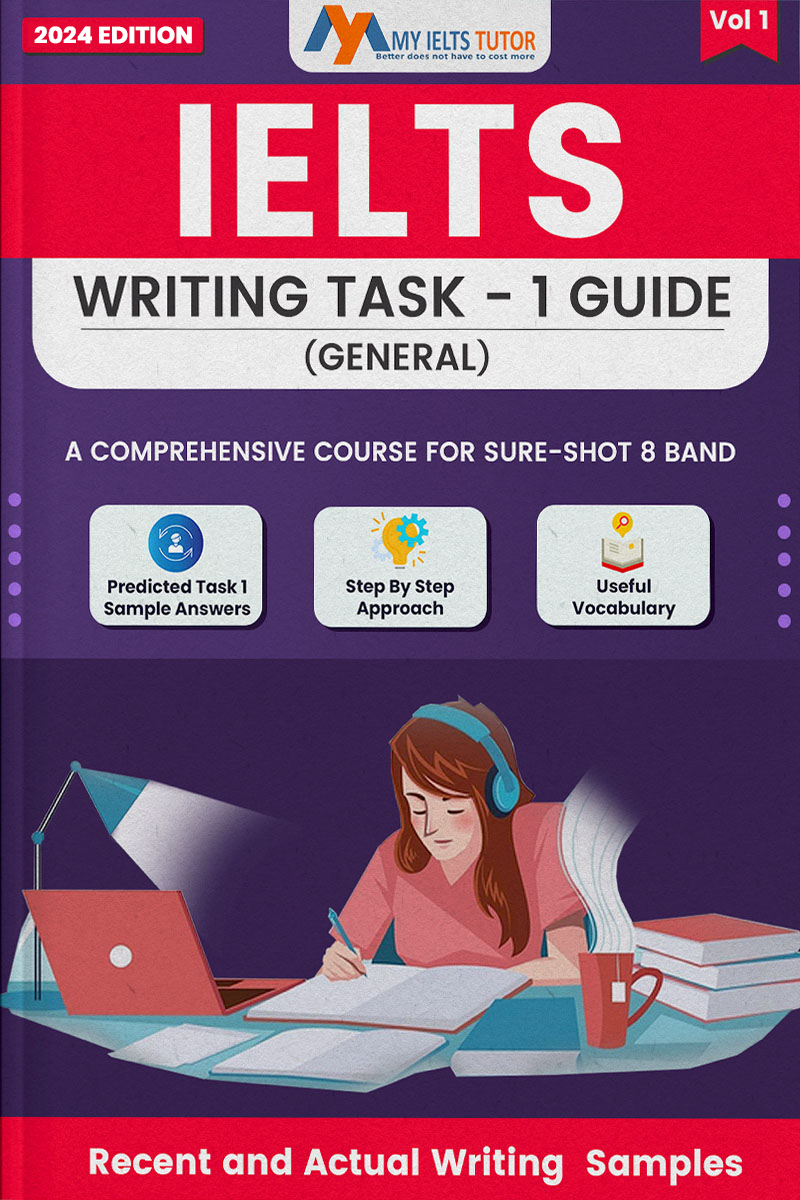 IELTS Writing Task 1 (General Training) 8 band writing guide (2024 Edition) Actual IELTS Practice questionsOriginal price was: $59.00.$29.00Current price is: $29.00.
IELTS Writing Task 1 (General Training) 8 band writing guide (2024 Edition) Actual IELTS Practice questionsOriginal price was: $59.00.$29.00Current price is: $29.00. -
Product on sale
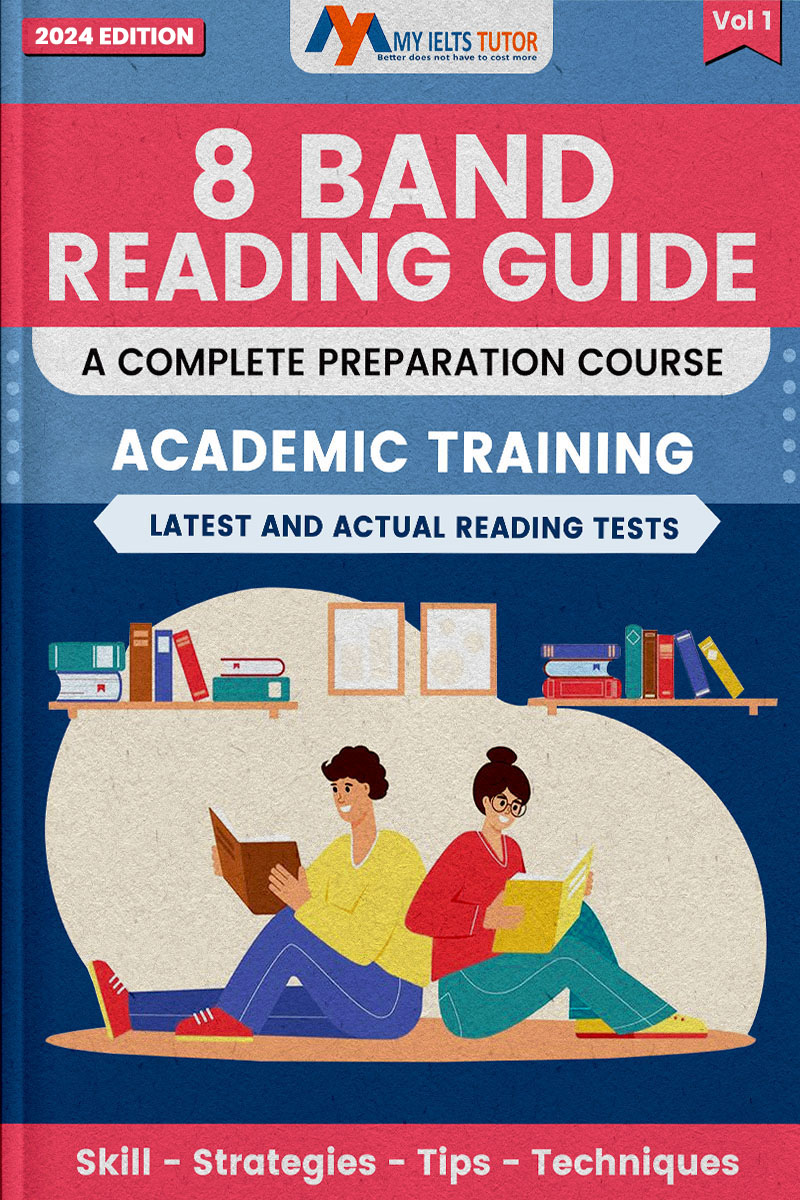 IELTS Academic Reading E-book – A Book With Actual Reading Tests- 2024 EditionOriginal price was: $69.00.$35.00Current price is: $35.00.
IELTS Academic Reading E-book – A Book With Actual Reading Tests- 2024 EditionOriginal price was: $69.00.$35.00Current price is: $35.00. -
Product on sale
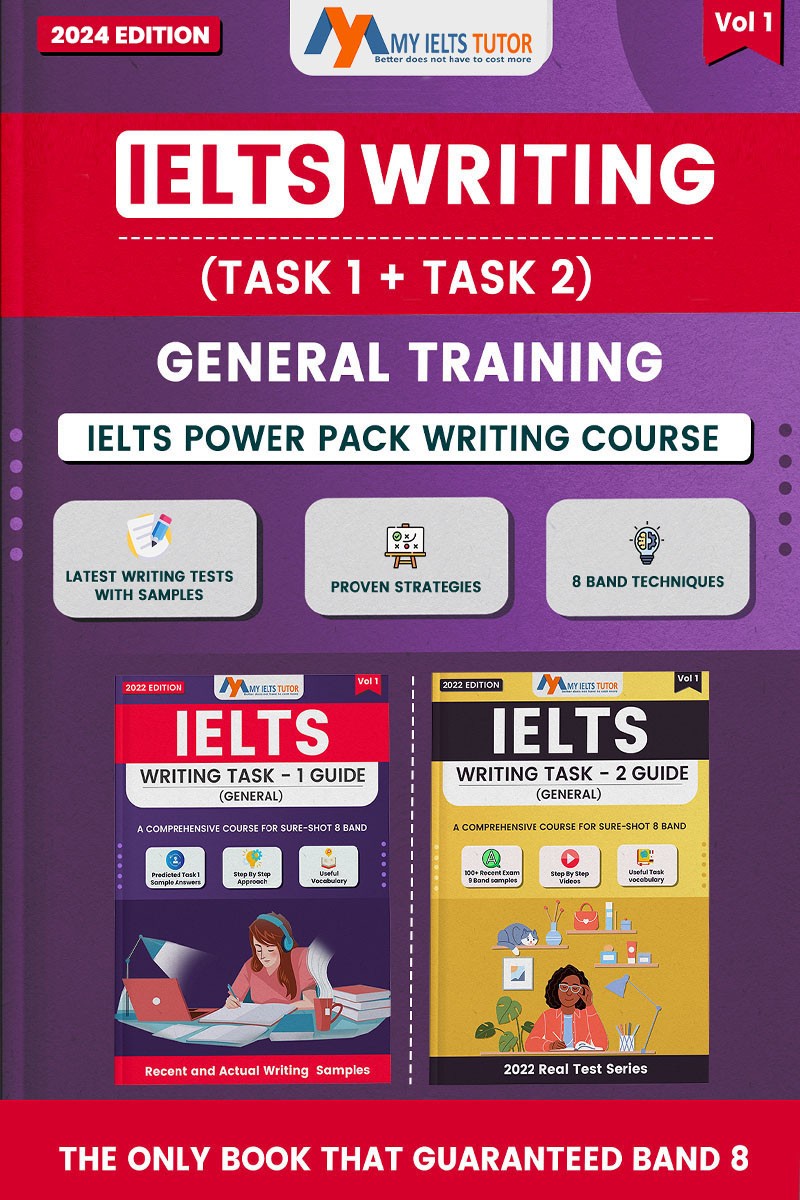 IELTS Writing (General Training) -A complete 8 band writing guide (2025 Edition )Original price was: $59.00.$29.00Current price is: $29.00.
IELTS Writing (General Training) -A complete 8 band writing guide (2025 Edition )Original price was: $59.00.$29.00Current price is: $29.00. -
Product on sale
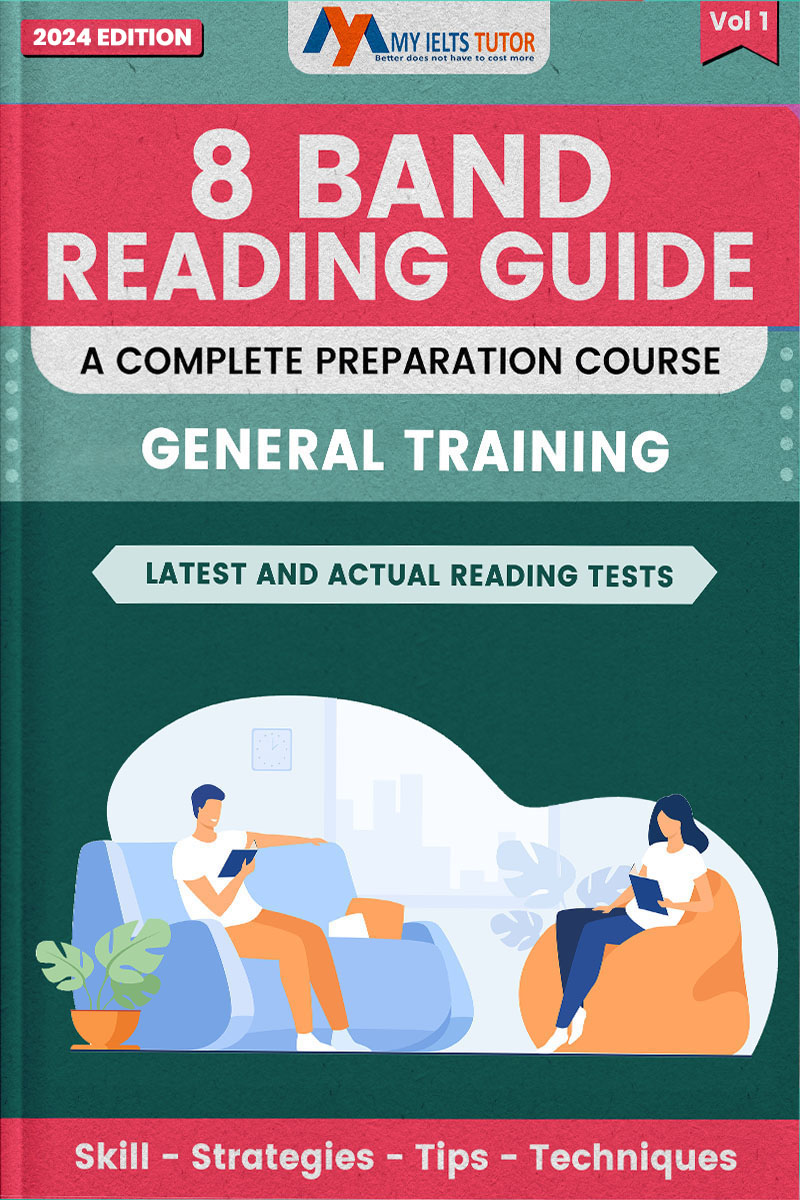 IELTS General Reading E-book – Complete Reading Success-2025 EditionOriginal price was: $69.00.$35.00Current price is: $35.00.
IELTS General Reading E-book – Complete Reading Success-2025 EditionOriginal price was: $69.00.$35.00Current price is: $35.00. -
Product on sale
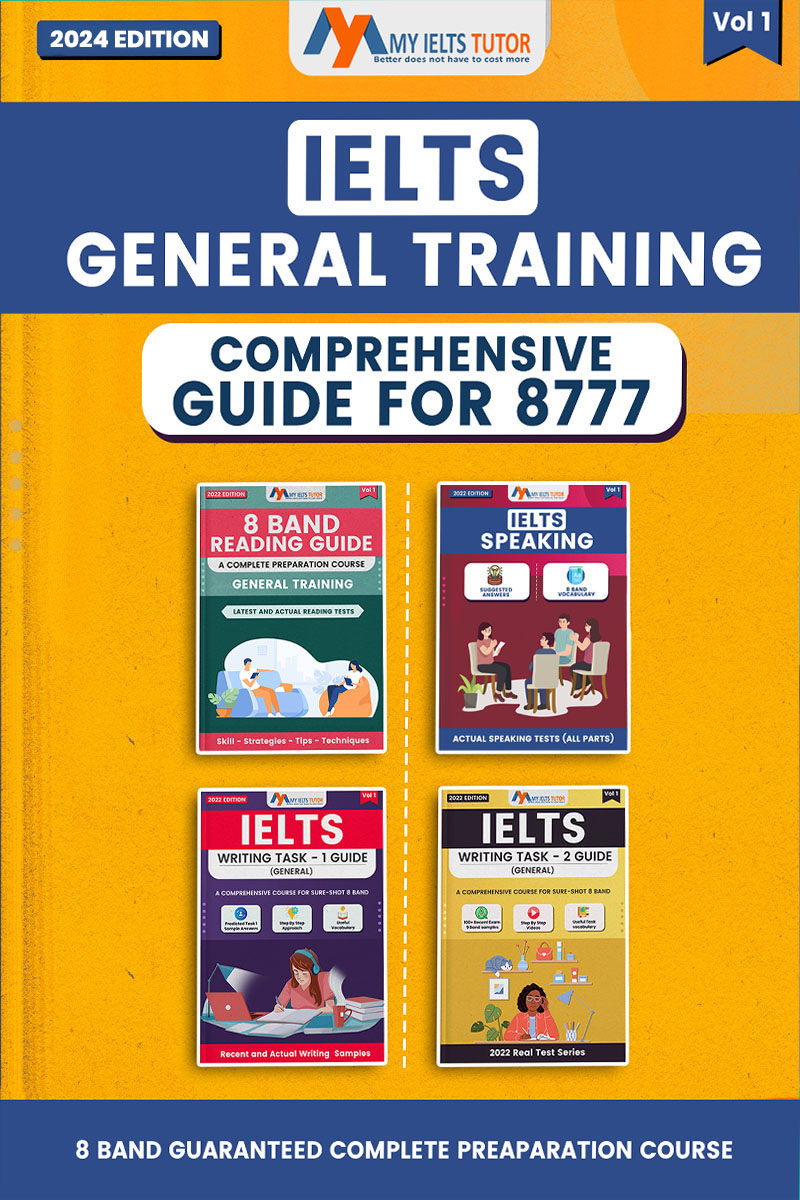 IELTS Preparation- General Training Combo (Comprehensive Course for 8777)Original price was: $99.00.$49.00Current price is: $49.00.
IELTS Preparation- General Training Combo (Comprehensive Course for 8777)Original price was: $99.00.$49.00Current price is: $49.00. -
Product on sale
 IELTS Writing Task 1 (Academic)- A Complete 8 band book with strategies (2025 Topics)Original price was: $69.00.$35.00Current price is: $35.00.
IELTS Writing Task 1 (Academic)- A Complete 8 band book with strategies (2025 Topics)Original price was: $69.00.$35.00Current price is: $35.00. -
Product on sale
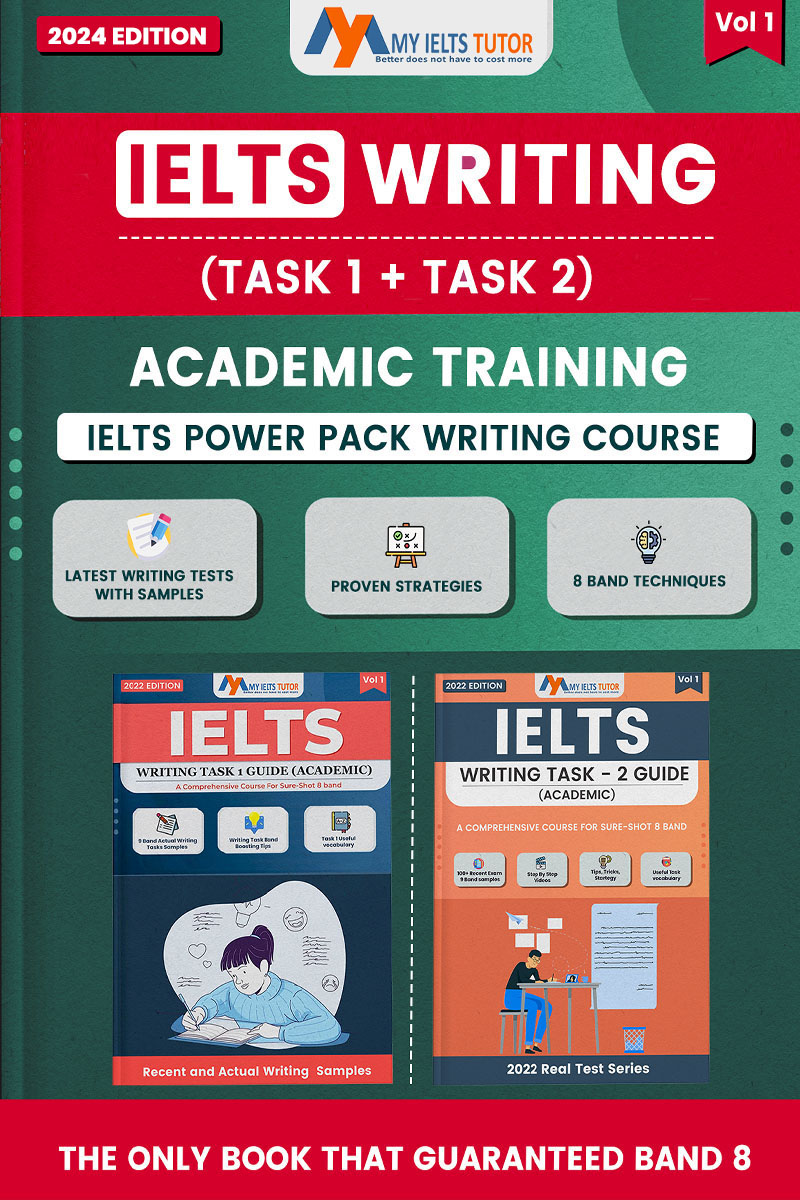 IELTS writing (Academic) -A complete 8 band writing guide (2025 Edition )Original price was: $59.00.$29.00Current price is: $29.00.
IELTS writing (Academic) -A complete 8 band writing guide (2025 Edition )Original price was: $59.00.$29.00Current price is: $29.00. -
Product on sale
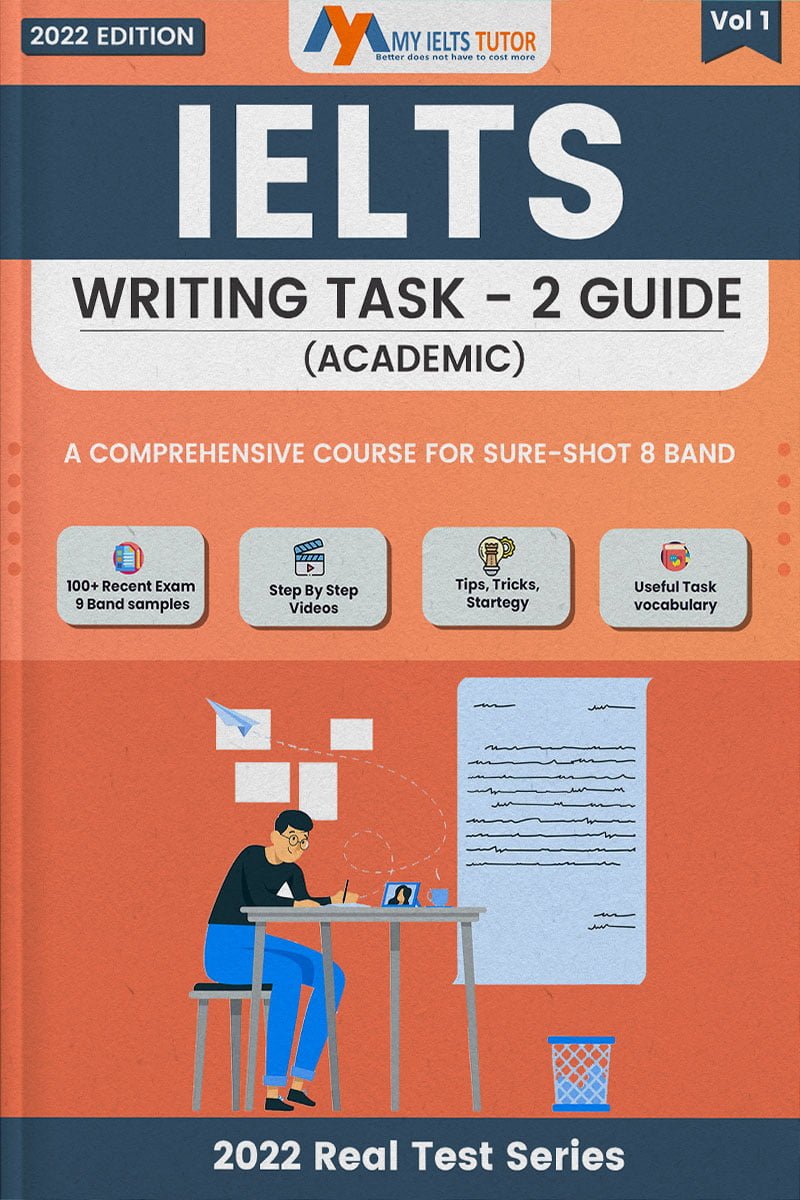 IELTS Writing task 2(Academic)- The ultimate 8 band Guide (2025 Edition ) Actual IELTS Practice questionsOriginal price was: $59.00.$29.00Current price is: $29.00.
IELTS Writing task 2(Academic)- The ultimate 8 band Guide (2025 Edition ) Actual IELTS Practice questionsOriginal price was: $59.00.$29.00Current price is: $29.00. -
Product on sale
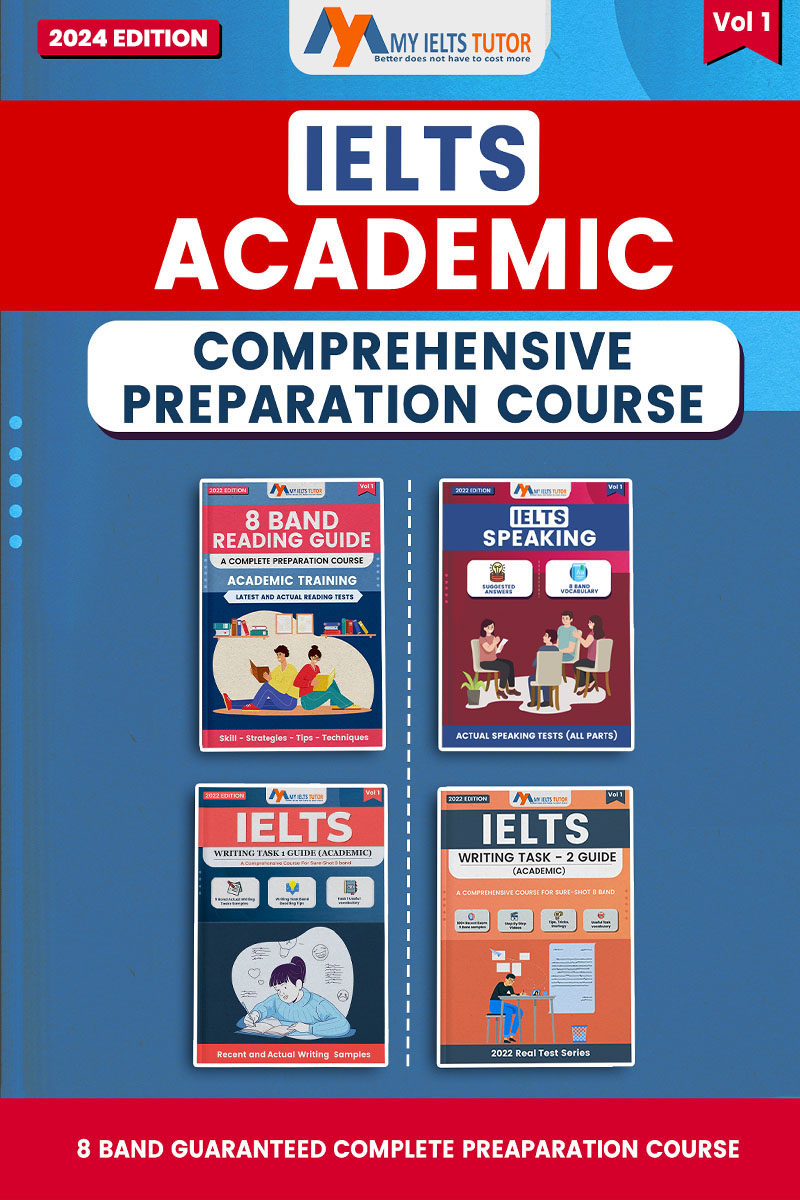 IELTS Material (Academic) – A Comprehensive 8 Band Material (All Modules In one)Original price was: $99.00.$49.00Current price is: $49.00.
IELTS Material (Academic) – A Comprehensive 8 Band Material (All Modules In one)Original price was: $99.00.$49.00Current price is: $49.00.
-
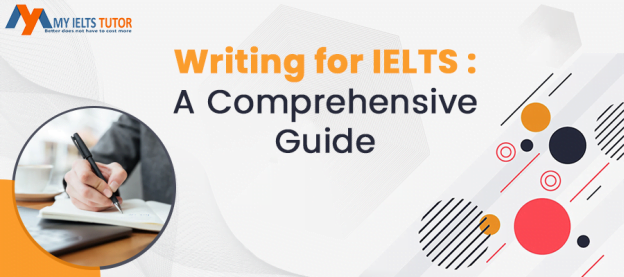
Writing for IELTS: A Comprehensive Guide
In this comprehensive guide, we’ll go over all aspects of the IELTS writing test. We’ll discuss the different types of essays you’ll be asked to write, and provide step-by-step instructions for how to write each one. Plus, we’ll give you tips and advice for staying motivated and overcoming writers’ block.
So whether you’re a beginner or an experienced IELTS writer, this guide has something for you. Let’s get started!
What Is the IELTS Writing Test?
The IELTS Writing Test is a test of your ability to write in English. You will be asked to write two essays: one Task 1 and one Task 2.
Task 1 is a letter For general training students and report for academic students . Task 2 is an essay on a more challenging topic.
The test is designed to assess your ability to communicate information, ideas, and arguments in writing. It is also designed to assess your ability to respond to questions and criticism about your writing.
Why Is Writing Important for IELTS?
When you’re taking the IELTS test, writing is one of the sections that counts for your final score. That’s why it’s so important to make sure that you spend enough time practicing and preparing for this section.
The good news is that there are a lot of resources out there to help you improve your writing skills. In fact, we have an entire section on our website dedicated to helping IELTS students improve their essay writing.
So why is writing so important for IELTS? Well, it’s not just about getting a good score on the test. Writing is a critical skill that you’ll need in academic and professional settings. That’s why it’s important to practice and develop your skills so that you can perform your best on test day.
How to Prepare for the IELTS Writing Test
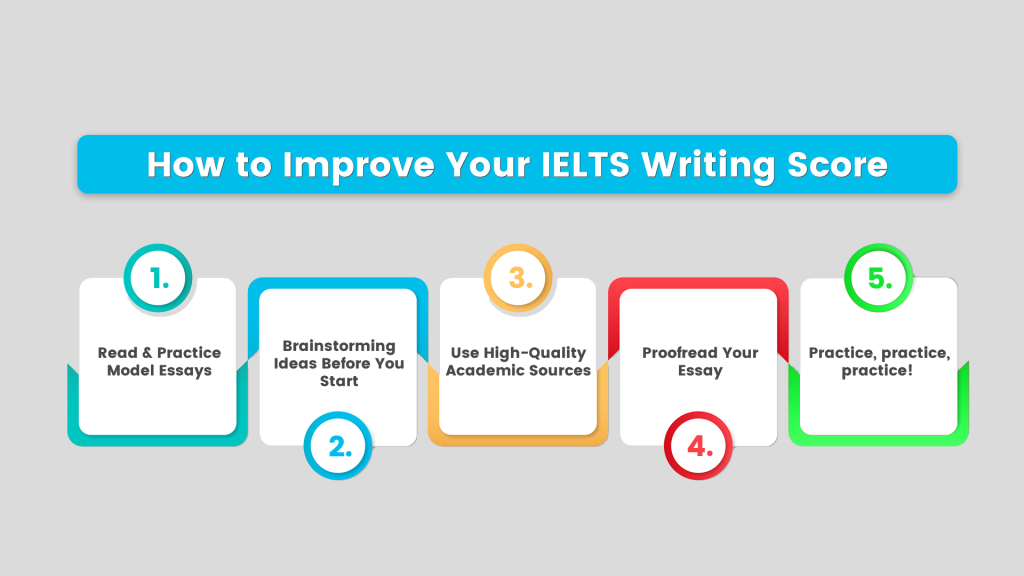
In order to ace the IELTS writing test, you need to practice, practice, practice. And that means working on your writing skills on a regular basis.
But it’s not just about practicing the actual writing task. You also need to be familiar with the types of questions that will be asked. So make sure you spend some time reading the IELTS test instructions carefully.
Equally important is knowing what the marking criteria are. So take a look at the marking grid and make sure you understand how your writing will be graded.
By following these tips, you’ll be well on your way to scoring high on the IELTS writing test!
What Are the Different Types of IELTS Writing Tasks?
In the IELTS writing test, there are two tasks: a task 1 and a task 2.
Task 1 is a report for academic training students , and it usually asks for information about a graph or table. In this task, you need to give a concise summary of the data, as well as describe any trends that you notice.
Task 1 for general training is letter writing and it usually asks to write a situation based letter may be to a friend, manager or boss. The relation with the person to whom you are writing the letter will decide the tone whether it will be a formal or an informal letter
Task 2 is an essay, and it asks for your opinion on a given topic. In this task, you need to develop your argument and provide evidence to support your point of view.
How to Plan and Structure Your IELTS Writing Task
Ok, so you’ve got your task, and now it’s time to plan and structure your essay. Here are a few tips to help you out:
- Plan your essay before you start writing. This means thinking about the main points you want to make and organizing them in a logical order.
- Start with a strong introduction that clearly states your position on the topic.
- Develop your argument using clear and concise points, making sure to support your points with evidence from the text.
- Use a variety of sentence structures to keep your writing interesting and engaging.
- Write a strong conclusion that sums up your argument and leaves the reader with something to think about.
How to Write an IELTS Essay
Now that we’ve covered the basics of IELTS writing, let’s take a look at how to actually write an essay. The best way to learn is by example, so let’s take a look at a sample question and see how we might go about answering it.
The question is: Some people think that the way to be successful is to make as much money as possible. Do you agree or disagree?
When you’re writing your essay, make sure to include your opinion on the matter. You don’t have to agree or disagree with the statement, but you should state your position either way. Here’s an example of how we might write this essay:
I think that the way to be successful is to find something that you’re passionate about and put your heart and soul into it. Money is important, but it shouldn’t be the only thing that drives you. There are many people who are successful without having a lot of money, and I think that’s because they’re doing something they love.
How to Write an IELTS Letter
When it comes to writing letters for IELTS, it’s important to remember that there’s a specific format you need to follow.
The general structure of a letter is usually:
- salutation – Dear sir/mam/john
- Opening paragraph
- Detailing paragraph(s)
- Closing sentence
- Signature
Within each of these sections, there are specific things you need to include. Let’s take a closer look. The opening paragraph should introduce the topic of your letter, and the main paragraph(s) should provide more detail. The closing sentence should thank the recipient for their time, and the signature should be your name followed by your signature.
IELTS Writing Task 1 – Academic
The 1st Task of the Academic Writing Module asks you to describe and summarise some information presented in a visual format (chart, table, graph or diagram) in about 20 minutes. Students, for this task, must write at least 150 words.
The Academic Writing Task 1 can be of the following types:
Types of Diagram What does it mean? Line Graph Shows Trend Bar Chart Shows Comparison Pie Chart Shows Contribution Table show any of the functions mentioned above Process Diagram or Flow Chart Shows Stepwise information Picture or Map Shows image IELTS Writing Task 1 Academic Answer Structure
For a high band score in Academic Writing Task 1, the students must structure their answers. First, we will look at a high band score answer structure for the first four categories mentioned above like Line Graph, Bar Chart, Pie Chart, & Table. Because the answer structure for a process or flow chart or a picture is different.
The students can structure their answers for the first four categories as below;
Paragraph Structure Opening Paragraph one paragraph consisting of 1 – 2 sentences explaining what you will describe. An Overview 1-2 Statements interpreting the key or significant features of the graph/map/process/picture Body The body structure may have a minimum of 2 paragraphs depending on the question asked, but they should not be more than 4. The students must answer the examiner’s demands in the body part. IELTS Writing Mistakes to Avoid
Are you preparing to take the IELTS Writing Exam? If so, you need to be aware of the most common mistakes people make.
One of the biggest mistakes is not paying attention to the task instructions. Make sure you read the question carefully and understand what’s being asked. Sometimes people try to be too clever and they end up writing something that’s completely irrelevant to the topic.
Another mistake is not organizing your thoughts properly. When you’re writing a paragraph, it’s important to have a clear idea of what you want to say and how you want to say it. Rambling on and on without any structure will only confuse the reader.
And finally, don’t forget to proofread your work! A lot of people make mistakes because they don’t bother to check their work for mistakes. This is a BIG mistake, because it can cost you marks in the final score.
Sample IELTS Writing Tasks
If you’re looking to improve your IELTS writing score, one of the best things you can do is practice. And what better way to practice than by working on sample tasks?
In this section, we’ve provided a range of sample tasks to help you get started. These tasks cover a variety of different topics, so you can get a feel for the different types of questions that come up in the test.
We’ve also included some tips and advice to help you start tackling these tasks. So don’t waste any time—get started today and see how much your score improves!
Conclusion
Congratulations on deciding to take the IELTS writing test! This document is designed to provide you with all the information you need to get a great score.
Inside, you will find:
- An introduction to the IELTS writing test
- The format of the writing test
- Advice on how to approach the task types
- Detailed guidance on how to generate ideas and write essays for each task type
- Sample answers to each task type
- Useful language for academic writing
- A glossary of terms
- Tips for improving your writing skills
You will also find a number of exercises to help you practice and improve your score. The more you practice, the better your score will be. Good luck!
[carousel_slide id=’16536′]
-

How to Improve Your IELTS Essay Score ?
You’ve just been given your IELTS essay score and it’s not what you were hoping for. Don’t worry, there are still a few things you can do to improve it quickly.
Here are a few tips to help you improve your IELTS essay score:
- Read the question carefully and make sure you understand it before you start writing.
- Make sure your essay is well organized and well written.
- Use strong, relevant examples to support your points.
- Make sure your grammar and spelling are correct.
- Proofread your essay carefully before submitting it.
- Practice, practice, practice! The more you write, the better your score will be.
- Get feedback from others and learn from their mistakes.
Follow these tips and you’ll see an improvement in your IELTS essay score in no time!
Introduction: What Is the IELTS Essay and Why Is It Important?
The IELTS essay is an important part of the IELTS exam. It’s your opportunity to show that you can communicate effectively in English. The essay is worth 25% of your total score, so it’s important to do well.
But don’t worry, you can improve your score quickly if you know what to do. Follow these simple tips, and you’ll be on your way to getting the score you need.
What Are the Main Criteria for the IELTS Essay?
When you’re writing your IELTS essay, there are three main criteria that your score will be based on:
- Task Achievement – how well you completed the task
- Coherence and Cohesion – how well your essay is written and how well it flows
- Lexical Resource – the range and accuracy of your vocabulary
- Grammatical Range And Accuracy – Using correct grammar and adding range of sentence structures.
How to Quickly Improve Your IELTS Essay Score
Tips, on the other hand, are an incredibly important and worthwhile component of this test. Tips are required to inform you of the most difficult and easiest sections of the paper. You can begin your preparation by following the instructions.
Overall, the guidelines give a foundation for the applicants’ preparatory path. It teaches them what to do and how to accomplish it. Let us now move on to tried and true ways for increasing your IELTS writing score.
Many tips are provided below to help you feel confident and at ease with the IELTS exam. It will provide you with information about the beginning and perfect structure of your answers in order for you to impress the examiners and obtain high scores.
Read the Statement thoroughly.
This is critical because if you don’t read accurately, you won’t be able to answer the questions precisely. All applicants must ensure a thorough reading the question. Dont miss to keep track of the keywords, so that you response to the task precisely. This will assist you in processing the meaning of the text. You will comprehend every aspect and become skilled at providing a response.Make a rough outline of the essay.
A basic framework makes it easier to conceive ideas and put them into action. This may appear to be an extra step, but if you have a clear sense of how to approach the issue, it will be quite easy to expand on that.The rough style allows you to easily and precisely transfer your ideas to paper. You can begin writing after first thinking and developing thoughts. It will quicken your writing rate and allow you to include all of the important details.
Make Use of a Variety of Linking Words
Linking words is the simplest basic and grammatically correct way to link ideas, sentences, or phrases in a piece of writing. You must show the examiner a variety of linking terms that are contextually suitable.
Watch out for misspelt words and grammar mistakes.
Nothing ruins an essay more than grammatical mistakes and misspelt words. You must have a keen eye to ensure that your sentences are free of grammatical and stylistic errors, and that your spellings are perfect.
Using Range in grammatical structures
Adding variety in grammatical structures showcase your flexibility in using the language. Using various structures like conditionals, clauses, complex structure, compound structures etcetera sophistically can take your band score in writing to 8.
Read Sample Essays and Get Feedback from expert
When you’re preparing for the IELTS test, it’s important to get feedback on your essays. That’s why we’ve included a few sample essays in this guide, as well as feedback from our expert team.
We’ve also highlighted some of the common mistakes people make when writing essays, so you can avoid them yourself. And lastly, we’ve included a few tips to help boost your essay score.
So what are you waiting for? Start reading!
Conclusion
Follow these simple steps to improve your IELTS essay score and get the result you need.
First of all, read the question carefully and make sure you understand what is being asked. Then, plan your essay carefully before you start writing, making sure you include all of the key points. Be clear and concise in your writing, and make sure your grammar and spelling are perfect. Finally, proofread your essay thoroughly before submitting it.
If you follow these steps, you’ll be able to improve your IELTS essay score quickly and easily.
-

Overcoming the Difficulty of IELTS Writing
IELTS writing can be a daunting task. It’s one of the most difficult papers you’ll ever have to write, and it can be tough to know where to start. The good news is that with a little preparation and practice, you can overcome the difficulty of IELTS writing.
In this article, we’ll provide some helpful tips for getting started on your IELTS writing task. We’ll also offer a few ideas for practice essays that will help you improve your score. With a little hard work, you can overcome the difficulty of IELTS writing and get the score you need to achieve your desired outcome.
Why Is IELTS Writing the Most Difficult Paper?
You may be wondering why IELTS Writing is considered the most difficult paper. Well, let me share with you some of the reasons.
To start with, the essay must be written in a formal style, and you are limited to 250 words. This means that you have to be concise and to the point. You can’t ramble on about irrelevant details, which can be challenging if you’re not used to writing in a formal style.
Another reason why IELTS Writing is so difficult is because you have to answer a question that’s been posed by the examiner. This can be tricky, because you need to provide an opinion and back it up with evidence.
Finally, there’s the task of organizing your thoughts into a cohesive essay. This can be particularly challenging if English isn’t your first language.
What Are the Challenges of IELTS Writing?
When it comes to IELTS writing, the most difficult paper is the essay. This is because you have to be well-organized, and you need to have a strong thesis statement.
But that’s not all. You also need to be able to back up your argument with evidence, and you need to make sure your grammar and spelling are perfect. It can be tough to do all of this in just 25 minutes.
That’s why it’s important to practice as much as possible. The more you write, the better you’ll become at it. And don’t forget to use the resources available to you, such as dictionaries, grammar checkers, and sample essays.
How to Improve Your IELTS Writing Score
It’s no secret that the IELTS Writing paper can be a challenge. But with a little bit of preparation and practice, you can boost your score and feel more confident on test day.
Here are a few tips to help you get started:
- Read model essays and practice writing different types of essays. This will help you become familiar with the format and structure of the IELTS essay.
- Make sure you understand the task and spend time brainstorming ideas before you start writing.
- Use high-quality academic sources to support your arguments and make your writing more convincing.
- Proofread your essay for grammar mistakes and spelling errors.
- Practice, practice, practice! The more you write, the better you’ll become.
Tips for IELTS Writing
So, you’re finding the IELTS Writing paper to be a bit more difficult than you had anticipated? Don’t worry, you’re not alone. In fact, this section is often considered to be the most challenging part of the entire test. But don’t let that discourage you! With a bit of preparation and practice, you can overcome the difficulty of IELTS Writing and get the score you need.
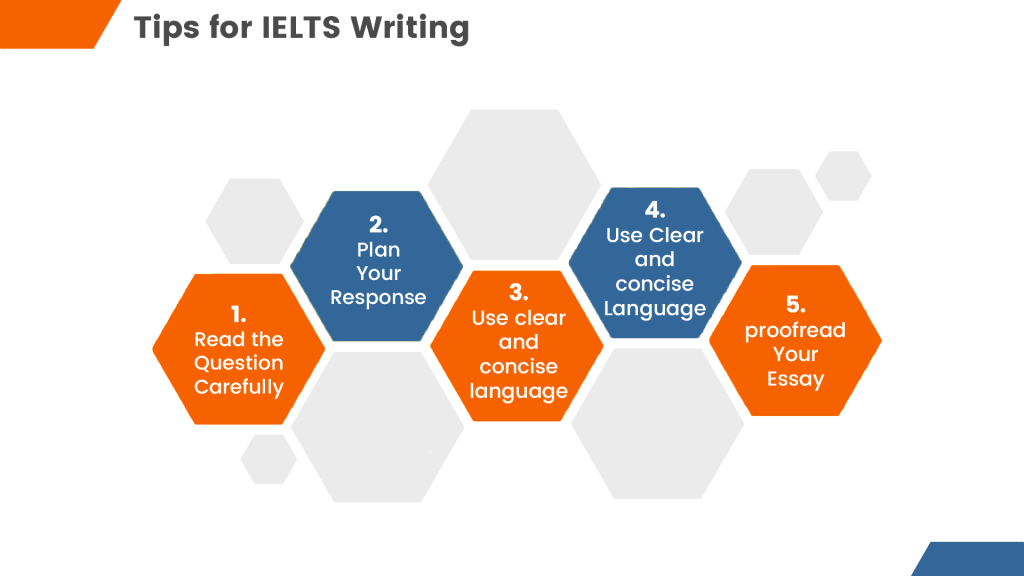
Here are a few tips to help you get started:
- Read the question carefully and make sure you understand what’s being asked.
- Plan your response before you start writing. This will help you stay organized and ensure that you cover all of the necessary points.
- Use clear and concise language throughout your essay.
- Make sure your grammar and spelling are accurate.
- Proofread your essay before submitting it.
Practice makes perfect, so be sure to drill these tips until they become second nature. And good luck on your test!
IELTS Writing Resources
You’ve probably heard that IELTS Writing is the most difficult paper of the test. And it’s true—it can be a real challenge to score well on this section.
But don’t worry, with the right resources, you can overcome the difficulty of IELTS Writing. Here are a few that I recommend:
- Practice questions and answers: The more practice questions you do, the better prepared you’ll be for the actual test. Try to find questions that are similar in style to those on the IELTS test.
- Online resources: There are a lot of great online resources that can help you improve your writing skills. Check out some of these websites.
- English language learning books: If you’re looking for a more comprehensive resource, an English language learning book can be a great option. These books often include exercises and quizzes to help you improve your writing skills.
- Workshops and classes: If you have the opportunity, attending a writing workshop or class can be a great way to improve your IELTS Writing skills. Workshops usually focus on specific areas of writing, such as task 1 or task 2, so you can get tailored feedback from an expert.
IELTS Writing Practice
You’re probably feeling overwhelmed right now, and that’s totally normal. The IELTS Writing exam is definitely one of the more difficult ones. But with a little bit of practice, you can overcome that difficulty and get the score you need.
The best way to practice is by doing as many exercises as possible. And don’t just do the exercises provided by your instructor. Surf the internet for more Writing practice tests. The more you do, the easier the actual exam will be.
And don’t forget to study the topic essays. Familiarizing yourself with the types of essays that will be covered in the exam will help you know what to expect on test day. Trust me, you want to go into that exam room feeling as prepared as possible.
Conclusion
The IELTS Writing paper can be one of the most difficult parts of the test, but with a bit of preparation and practice, you can overcome any challenges you face.
Here are a few key tips to help you prepare for the IELTS Writing paper:
- Familiarize yourself with the task types and questions types.
- Practice writing essays under time pressure.
- Read a variety of different genres to improve your vocabulary.
- Stay calm and positive – it will help you think more clearly under pressure.
With a bit of effort, you can overcome the difficulty of IELTS Writing and get the score you need for your dream university. Good luck!
-

How to Boost IELTS Band Scores by Learning Grammar?
IELTS assesses a candidate’s English language proficiency based on the four criteria: task achievement, coherence and cohesion, lexical resource, and grammatical range and accuracy making learning and studying grammar vital to boost IELTS Band Scores.
It is an exam to record your answers either by writing or speaking in English; hence, using him instead of her represents incorrect pronouns meaning a sentence wrong grammatically. Knowing the basics of grammar and its correct usage is essential to enhance your IELTS Band Scores.
Still, can studying only grammar help improve band scores from 6- 7,8 or overall nine bands? If yes, how?
When it comes to the IELTS exam, grammar is inherent to encounter, but skillfully. One must know how to frame a sentence while speaking or writing a solution as per the examiner’s requirements.
We all are afraid of grammar, maybe because of its difficulty and a less fun learning experience. Therefore, we have come up with a few ways to tackle it and enhance your IELTS scores easily.
How to boost IELTS band scores by learning grammar?
Examiners Assessment Criteria
Understanding the exact usage of grammar rules and certain words helps improve one of the examiners’ assessment criteria: grammatical range and accuracy.
In this particular criteria, the examiner looks out for errors in your sentences, if any, and reviews the wide range of sentences you use in your solution. Therefore, acknowledging the rules of grammar and studying them well can aid you to improve your IELTS scores to a great extent.
Know the Basics of Grammar and its Usage
While learning grammar, we have all come across terms like Noun, Pronoun, Adjective, Verb, Tenses, Passive or Active, but their proper usage in a sentence has always been challenging for many. For example, their or there in a sentence. There is used to describe someone’s something, say “The pink one is their house” or “Tommy is their dog” likewise There is used to describe a place “Place the couch
right over there” or “Do not stand there”.While writing your solution, know the essential words and their usage grammatically.
A point to note here is knowing to write a sentence in the English language is easy, but the challenge is understanding the basic grammar rules such as; with ‘one of _______ ‘, use of a plural form is a must.
Whether you write or speak the exam solution, one common mistake – “He is one of my friends.” or “He is one of my friends” can cost you 1 or 2 band scores.
There is a lot to grammar that is not a game understood with one article or a day of practice; it involves hard work to be the expertise. However, owing to IELTS, one can be an expert knowing how to frame a sentence intelligently. Another example is crafting a sentence in a simple or complex structure;
Simple Sentence Structure: She is wealthy. She is unhappy.
Complex Sentence Structure: Although she is wealthy, she is unhappy.
Quick homework, Identify the errors;
1. I met Mary two years before.
2. This is a six-month course.
3. They reached an agreement.
4. He is one of my friends.Answer –
1. I met Mary two years ago.
2. This is a six-month course.
3. They reached an agreement.
4. He is one of my friends.
Research more to study grammar to improve your bands.Affect Another Marking Criterion
Do you know that studying grammar not only improves the marking of grammatical range and accuracy but it also affects other marking criteria as well?
Accurately crafted sentences help arrange your ideas precisely and advance the sequence of your presented thoughts, marking a band for task achievement coherence, and cohesion.
Moreover, when you study grammar, you come across a variety of different words, enhancing your solution’s vocabulary aiming you a high-scoring IELTS band in the lexical resource marking criteria. For example, for the term ‘free of cost’, one can use other natural words such as; absolutely free or without any charge.
Rewrite the sentence: Some people think that University Education should be free for everyone.
[Here, one can use Tertiary Education or Higher Education for University Education.]Practice Grammar for IELTS Test
Now that you know a few ways to boost IELTS Band Scores by learning grammar, practice accordingly to achieve your aim.
Practice more & more is the only key to getting your desired marks. The above tips and tricks have helped thousands of candidates appearing for the IELTS test increase their scores by advancing their grammar.
Read more :
IELTS Listening – How to Solve Flow Chart?
IELTS Reading – Fill in the Blanks Tips Tricks & Strategies
IELTS Reading – Matching Paragraph Information Quickly and Accurately
IELTS Reading Matching Headings – Important Tips and Strategies with Solved Sample

